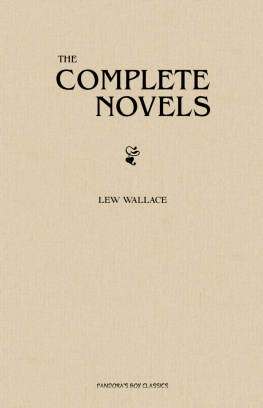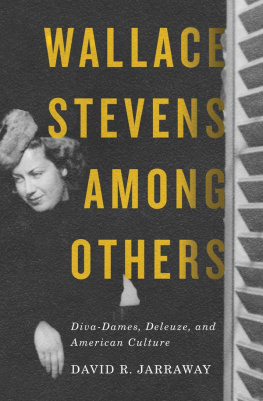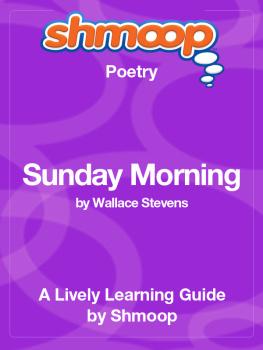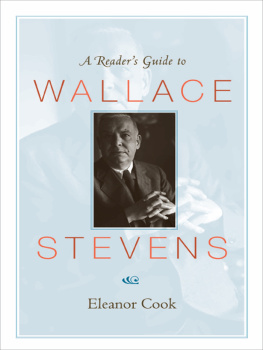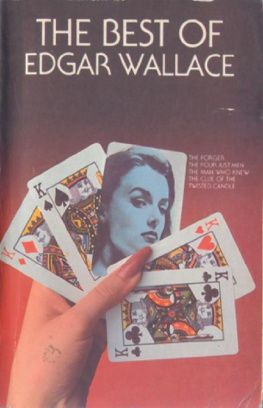Richardson Joan - How to live, what to do: thirteen ways of looking at Wallace Stevens
Here you can read online Richardson Joan - How to live, what to do: thirteen ways of looking at Wallace Stevens full text of the book (entire story) in english for free. Download pdf and epub, get meaning, cover and reviews about this ebook. year: 2018, publisher: University of Iowa Press, genre: Religion. Description of the work, (preface) as well as reviews are available. Best literature library LitArk.com created for fans of good reading and offers a wide selection of genres:
Romance novel
Science fiction
Adventure
Detective
Science
History
Home and family
Prose
Art
Politics
Computer
Non-fiction
Religion
Business
Children
Humor
Choose a favorite category and find really read worthwhile books. Enjoy immersion in the world of imagination, feel the emotions of the characters or learn something new for yourself, make an fascinating discovery.

- Book:How to live, what to do: thirteen ways of looking at Wallace Stevens
- Author:
- Publisher:University of Iowa Press
- Genre:
- Year:2018
- Rating:3 / 5
- Favourites:Add to favourites
- Your mark:
- 60
- 1
- 2
- 3
- 4
- 5
How to live, what to do: thirteen ways of looking at Wallace Stevens: summary, description and annotation
We offer to read an annotation, description, summary or preface (depends on what the author of the book "How to live, what to do: thirteen ways of looking at Wallace Stevens" wrote himself). If you haven't found the necessary information about the book — write in the comments, we will try to find it.
Richardson Joan: author's other books
Who wrote How to live, what to do: thirteen ways of looking at Wallace Stevens? Find out the surname, the name of the author of the book and a list of all author's works by series.
How to live, what to do: thirteen ways of looking at Wallace Stevens — read online for free the complete book (whole text) full work
Below is the text of the book, divided by pages. System saving the place of the last page read, allows you to conveniently read the book "How to live, what to do: thirteen ways of looking at Wallace Stevens" online for free, without having to search again every time where you left off. Put a bookmark, and you can go to the page where you finished reading at any time.
Font size:
Interval:
Bookmark:
HOW TO LIVE, WHAT TO DO
MUSE BOOKS
The Iowa Series in Creativity and Writing
Robert D. Richardson, series editor
How to Live, What to Do
THIRTEEN WAYS OF LOOKING AT WALLACE STEVENS
JOAN RICHARDSON
UNIVERSITY OF IOWA PRESS, Iowa City
University of Iowa Press, Iowa City 52242
Copyright 2018 by the University of Iowa Press
www.uipress.uiowa.edu
Printed in the United States of America
Design by Richard Hendel
No part of this book may be reproduced or used in any form or by any means without permission in writing from the publisher. All reasonable steps have been taken to contact copyright holders of material used in this book. The publisher would be pleased to make suitable arrangements with any whom it has not been possible to reach.
The University of Iowa Press is a member of Green Press Initiative and is committed to preserving natural resources.
Printed on acid-free paper
Library of Congress Cataloging-in-Publication Data
Names: Richardson, Joan, 1946 author.
Title: How to live, what to do : thirteen ways of looking at Wallace Stevens / Joan Richardson.
Description: Iowa City : University Of Iowa Press, [2018] | Series: Muse books | Includes bibliographical references and index.
Identifiers: LCCN 2017039377 (print) | LCCN 2017050860 (ebk) | ISBN 978-1-60938-550-7 (ebk) | ISBN 978-1-60938-549-1 (pbk : acid-free paper)
Subjects: LCSH: Stevens, Wallace, 18791955Criticism and interpretation. | BISAC: LITERARY CRITICISM / Poetry. | BIOGRAPHY & AUTOBIOGRAPHY / Literary.
Classification: LCC PS3537.T4753 (ebk) | LCC PS3537.T4753 Z7579 2018 (print) | DDC 811/.54dc23
LC record available at https://lccn.loc.gov/2017039377
To the memory of ROBERTO PICCIOTTO
&
for my teachers and students
The river is moving.
The blackbird must be flying.
CONTENTS
ABOUT THE BOOK
My involvement with Wallace Stevens and his work began a long time ago, in a high school infatuation with his anthologized poems; it continued through my undergraduate years, when I hoped that my training in philosophy (my major) might help me penetrate his complexly beautiful surfaces to reach meanings, to get to the true subjects of his poems. My doggedness persisted: in graduate school I first pursued the history of metaphor, beginning with the pre-Socratics and ending with the symbolist poets, before going onproperly prepared, I thoughtto complete a dissertation on Stevens. But still the greater number of his poems remained opaque. I then spent the next ten years or so reading everything I knew Stevens had read as I imagined him moving through the cycles of his life, from his childhood in Reading, Pennsylvania, through his maturity, aging, and death in Hartford, Connecticut. The constant in this passage was his attention to light.
In composing the two-volume critical biography that is the record of what I learned through those years, I attempted to make my sensibility his as much as possible, even for a while cultivating the habit of drinking martinis, Stevenss preferred beverage at lunch; the waitress at the Canoe Club in Hartford even knew that Stevenss order of a martini meant a pitcher. I restricted myself to cocktail hour and one martini glassafter all, Stevens was a tall and portly man. In any case, I did not realize how successfully I had mimicked my subject until I set downwith fountain pen on foolscapthe last words of my biographys final chapter, the poets bond to all that dust, and then looked out the window at the leaves trembling in the light summer air to find myself almost completely undone as I recognized that after so many years I was seeing the leaves with my own eyes again. At that moment I knew I would never undertake another biography. Yet the relationships I developed with some of the studious ghosts I came to know through tracking Stevens have become as intimate as, if not more intimate than, the relationship I continue to enjoy with him as interior paramour. This is especially the case with William James, whom I currently characterize playfully to my students as my best imaginary friend, although for a long time the designation belonged to Ralph Waldo Emerson. And my involvements with Jonathan Edwards and Charles Sanders Peirce also continue to deepen. In the truest sense, Wallace Stevens has educated and continues to educate me.
When Bob Richardsonthere is no family connection, as far as we knowasked me to consider writing a volume on Stevens for the Muse Books series, I resisted. I did not want to immerse myself in Stevens againparticularly because a long-range creative project of my own was beckoning for full attention, but also because I could not immediately imagine how I could offer, within a twenty-five-thousand word limit, everything a reader new to Stevens would need to know in order to move easily in his fluent mundo. But if I resisted undertaking the project, I found it impossible to resist Bob, whose intellectual contributions and companionship over the decadesdespite the fact that we have been in each others actual presence on only one occasionhave provided me with essential nourishment. It was out of my deep appreciation of and gratitude to him that I acceded to his request and put together a proposal for How to Live, What to Do. It was only after pondering for a good while how to do what I proposed that I devised its form, and so was added the subtitle, Thirteen Ways of Looking at Wallace Stevens.
Once I embarked on the project, the thirteen headings presented themselves with unexpected insistence, as though from some deep well within me. I thought of my task as somewhat similar to that set for himself by one of Stevenss favorite contemporary philosophers, who under the pen name Alain (Emile Chartier, 18681951) published regular columns in a provincial French newspaper in which he dealt with significant philosophical subjects but in language accessible to a nonprofessional, nonspecialist audience. Alain allowed himself eleven hundred words for each column, composed without erasures or cross-outs. While I did not impose on myself the same severe discipline, keeping roughly within a two-thousand word limit for each of the thirteen ways changed the nature of my relationship with thinking and writing: word count, as any good journalist or practitioner of haiku knows, demands that every word must indeed count. Forging each sentence against the constraint of concisiona primary virtue for Henry James, although on the surface one would be hard put to see his novels as evidenceforces an acute attention to and distillation of thinking, the measure of which is an inverse relationship between time and space: the time spent in composing and the space on the page. This kind of exercise turns out to be the ideal corrective to life in our moment, when for most of us it seems as if there is no time left to think. In our accelerated climate we do gradually but actually lose the sense of thinking, how it feels. It was most appropriate to Stevens that this project imposed its limit, since it is, finally, thinking that was his subject. Without the enforced verbal economy, I would not have become so keenly sensitive to the difficult wonder that thinking is, coming to experience fully the fact informing Jonathan Edwardss piercing observation, The mind feels when it thinks.
Within the economy of this volume readers might at first be surprised to find certain repetitions. They are deliberate, reflecting a manner of recursive amplification that characterizes not only Stevenss style but also the actuality of my witnessing, attending to, and recording the process of thinking that this text represents. What I am referring to here will become clear as readers move through the thirteen ways. I have also intentionally not indicated page numbers for the quoted phrases and lines from Stevenss poems embedded in my text, for two reasons. First, these fragments arise as they do because they have become part of my language; one could fairly say that I have learned to speak Stevens. I did not, in thinking, go searching for these locutions; they are essential elements of my thinking. Second, when readers do not recognize the poem from which the words are taken but find themselves
Next pageFont size:
Interval:
Bookmark:
Similar books «How to live, what to do: thirteen ways of looking at Wallace Stevens»
Look at similar books to How to live, what to do: thirteen ways of looking at Wallace Stevens. We have selected literature similar in name and meaning in the hope of providing readers with more options to find new, interesting, not yet read works.
Discussion, reviews of the book How to live, what to do: thirteen ways of looking at Wallace Stevens and just readers' own opinions. Leave your comments, write what you think about the work, its meaning or the main characters. Specify what exactly you liked and what you didn't like, and why you think so.

